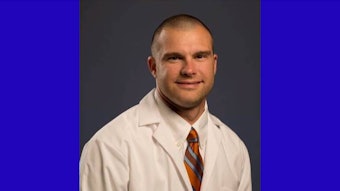Research reveals the next right thing
Panelists share first-hand experience of emergency airway management.

Airway management performed in the emergency department or intensive care unit is radically different from performing it in the OR. Not only are providers often unfamiliar with the patient, but they are operating on someone who is critically ill with injured or suboptimal lungs.
The 2024 panel, “Emergency Airway Management in Out-of-OR Locations,” addressed key techniques, challenges, and approaches to providing care during these complex, high-stress procedures. Craig S. Jabaley, MD, Associate Professor of Anesthesiology at Emory University Medical Center and Medical Director of the Cardiothoracic ICU at Emory University Hospital in Atlanta, served as moderator of the session.
Identify what could go wrong
Kunal Karamchandani, MD, FCCP, FCCM, was the first of three speakers to reference the international Delphi study “Swedish Consensus Regarding Difficult Pre-hospital Airway Management,” which published earlier this year. The authors of the paper, as well as the panelists, agreed that it is critical for hospitals to have a uniform process for emergency airway management, given all the variables that can occur.
Dr. Karamchandani, who is a professor in the Department of Anesthesiology and Pain Management at the University of Texas Southwestern Medical Center in Dallas, also referred to INTUBE. This was a global, large-scale, observational study that examined the impact of airway management in critically ill patients to understand and form best practices. One of the biggest findings was that nearly 50% of patients had at least one major adverse event during peri-intubation. Of these, almost half of them had cardiovascular instability or collapse.
Clinicians face three main challenges when performing emergency intubation, said Dr. Karamchandani. A patient may have an anatomically difficult airway, which is even more problematic to treat in a crisis scenario than in the planned OR. There can be logistical factors, such as infrastructure (tight space, limited access, insufficient monitoring), personnel (poor communication, inadequate training, fixation errors), or equipment/drug.
There is also the familiar scenario, he said, where an anesthesiologist encounters a patient, whose labs are normal and the tube goes in immediately, but then things go awry. Common characteristics that can quickly develop include hypoxia, right ventricular dysfunction, raised intracranial pressure, and significant GERD.
“Physiological and pathophysiological derangements increase the risk of complications with intubation and conversion to positive pressure ventilation,” Dr. Karamchandani said.
Create a structure
Therefore, if the things that can occur are known, clinicians can prepare for the unknown. The key to laying a foundation for this approach is optimization, said Mary L. Jarzebowski, MD, Clinical Assistant Professor of Anesthesiology at the University of Michigan in Ann Arbor.
“As patients get older, sicker, critically ill, you have less time to preoxygenate and optimize your surroundings,” she said.
Dr. Jarzebowski addressed what anesthesiologists can do to counteract this:
- Optimize hemodynamics: Everyone knows about and uses vasopressors, like phenylephrine, when cardiovascular collapse occurs, she said. However, physical data to corroborate which one to use, how much, and the preferred application don’t exist yet.
- Optimize oxygenation: Recent studies have proven that noninvasive ventilation is the best method, and using a mask can help.
- Optimize care team: To mitigate human factors, develop a standardized checklist that can be used to debrief. Assigning roles, setting clear expectations, and having a minimum of three providers (with one experienced) present are musts.
Remember, the first time is the right time
Sheila N. Myatra, MD, FCCM, Professor of Critical Care Medicine at Tata Memorial Hospital in Mumbai, India, recalled several studies to emphasize that the best tools and techniques are not being used enough worldwide, even in developed countries.
Dr. Myatra told attendees that propofol should be avoided in emergent settings, and that anesthesiologists should be performing modified rapid sequence intubation to prevent perioperative complications. Research shows that ketamine is slightly favored over etomidate, but both work well, she said.
Next, it is imperative that care teams are trained on and have access to videolaryngoscopy. It is the superior method, said Dr. Myatra – it improves glottic view (which all clinicians can see) and reduces the incidence of esophageal intubation. This can be performed with a stylet or bougie, she said, but these tools must be used to improve intubation success on first attempt, and not as a means to rescue. Providers should also employ waveform capnography to confirm tube position and monitor complications, if any.
Finally, Dr. Myatra left attendees with an important reminder: “Intubation is a lifesaving procedure that can turn into a life-threatening situation if not managed appropriately.”











